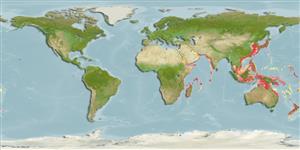Classification / Names
ชื่อสามัญ | ชื่อพ้อง | Catalog of Fishes(สกุล, ชนิด) | ITIS | CoL | WoRMS | Cloffa
Environment: milieu / climate zone / depth range / distribution range
นิเวศวิทยา
เกี่ยวกับทะเล,น้ำเค็ม สัตว์น้ำหน้าดิน; ระดับความลึก 46 - 100 m (Ref. 11441). Tropical; 42°N - 22°S, 55°E - 141°E
Indo-West Pacific: Funka Bay of Hokkaido to the South China Sea and farther south (Ref. 559). Recorded from Oman (Ref. 11441).
Length at first maturity / ขนาด / น้ำหนัก / Age
Maturity: Lm 6.8, range 7 - 7 cm
Max length : 14.8 cm TL เพศผู้/กระเทย; (Ref. 125279); น้ำหนักสูงสุดที่มีการรายงาน: 15.20 g (Ref. 112063)
เงี่ยงครีบหลัง (รวม): 8; ก้านครีบอ่อนที่หาง (รวม): 9; เงี่ยงครีบก้น 2; ก้านครีบอ่อนที่ก้น: 8. Ten to 12 brown bands on sides of body. Number and width of these bands varies with habitat. Body shape and coloration closely resembles A. ellioti, but distinguished by not having luminous organ. Attains 8 cm TL.
Abundant on sandy and muddy bottoms from coastal inlets to deeper waters (Also Ref. 11230). Breeding season is from July to September. Males brood eggs in the mouth. Made into fish paste (Ref. 559 and 637).
Mouthbrooders (Ref. 240). Distinct pairing during courtship and spawning (Ref. 205).
Masuda, H., K. Amaoka, C. Araga, T. Uyeno and T. Yoshino, 1984. The fishes of the Japanese Archipelago. Vol. 1. Tokai University Press, Tokyo, Japan. 437 p. (text). (Ref. 559)
IUCN Red List Status (Ref. 130435)
Threat to humans
Harmless
Human uses
ข้อมูลเพิ่มเติม
อ้างอิงการเพาะเลี้ยงสัตว์น้ำประวัติการเพาะเลี้ยงสัตว์น้ำสายพันธุ์พันธุศาสตร์ElectrophoresesอัตราพันธุกรรมโรคการแปรรูปNutrientsMass conversion
ผู้ร่วมมือรูปภาพหลายรูปStamps, Coins Misc.เสียงปลามีพิษ เช่น ปลาปักเป้าความเร็วรูปแบบการว่ายน้ำพื้นที่เหงือกOtolithsสมองวิสัยทัศน์
เครื่องมือ
Special reports
Download XML
แหล่งที่มาจากอินเตอร์เน็ต
Estimates based on models
Preferred temperature (Ref.
123201): 17.3 - 28.1, mean 26.4 °C (based on 345 cells).
Phylogenetic diversity index (Ref.
82804): PD
50 = 0.5000 [Uniqueness, from 0.5 = low to 2.0 = high].
Bayesian length-weight: a=0.01413 (0.00837 - 0.02384), b=3.18 (3.03 - 3.33), in cm total length, based on LWR estimates for this species & (Sub)family-body (Ref.
93245).
ระดับชั้นอาหาร (Ref.
69278): 3.7 ±0.5 se; based on diet studies.
ความสามารถในการกลับคืนสู่ปกติ (Ref.
120179): ความสูง, เวลาต่ำสุดที่จะทำให้ประชากรเพิ่มขึ้นเป็น 2 เท่าใช้เวลาน้อยกว่า 15 เดือน (tm=1; K=0.37-1.12; Tmax=3-5).
Fishing Vulnerability (Ref.
59153): Low vulnerability (12 of 100).
